The life-changing effects of hallucinations

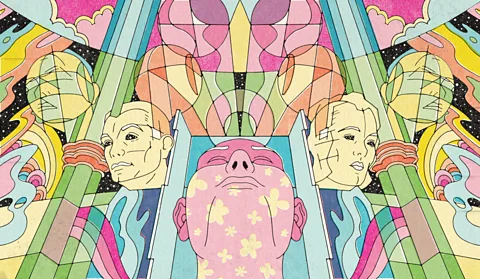 Emmanuel Lafont/BBC
Emmanuel Lafont/BBCIllusions brought on by drugs, lights and disease are giving us new insights into the inner workings of our brains. William Park ventured into his own induced hallucination to find out more.
The Huichol tribe from the Sierra Madre Occidental mountains in Mexico can speak to spirits. They leave our Earthly plane to visit animals and ancestors with the assistance of a small, green cactus.
The cactus, called peyote, is cut into discs and chewed raw to release a hallucinogen. A peyote trip starts with a "growing sense of euphoria", followed by a heightened sense of the noises around, before the tipper is plunged into a world of vivid dreams – at least that is how anthropologist Barbara Myerhoff described her experience after taking peyote with members of a Huichol tribe in western Mexico in her book Peyote Hunt.
Peyote contains mescaline – a psychedelic compound that can produce hallucinations similar to the effects of taking magic mushrooms. The discs taste "unspeakably bitter-sour" and "revolting" explains Myerhoff, but she adds that she lost her awareness of time, and instead started to skip from one vivid, self-contained dream to another. "Although I discovered that I couldn't move, I was able to remain calm when it occurred to me that this was of no consequence because there was no other place that I wanted to be," she writes, noting that she found the experience not in the least scary, but deeply moving.
Psychedelics have been used in religious ceremonies, before war and for recreation in the Americas for centuries. For example, ayahuasca, a hallucinogenic drink made from certain brewed vines or shrubs, has been consumed by indigenous peoples in South America during religious and healing rituals for perhaps as long as 1,000 years. The Olmecs – one of the earliest Mesoamerican civilisations – and Maya people from Mexico are also thought to have used the neurotoxin from cane toads to hallucinate in their rituals. They believed they could speak to ancestors after taking a very small dose of dried toxin (too much would be fatal).
Why were these psychedelics used in rituals? Possibly because they elicit in the user a sense of awe and wonder. Medium to high doses of similar hallucinogens generate lasting feelings of bliss and insightfulness and a sense of profound spiritual enlightenment.
In the 1950s and 60s, there was a great deal of interest in psychedelics as a treatment for disorders from depression and alcohol addiction to schizophrenia. The US even ran experiments under the names Project MKUltra and Project MKDELTA to see if LSD could be used as a truth drug. While research into the therapeutic benefits of hallucinogens was largely paused after LSD was criminalised in the late 60s, there has recently been a renewal of interest in using hallucinogens such as ketamine and LSD as therapeutic treatments, with a spate of new studies.
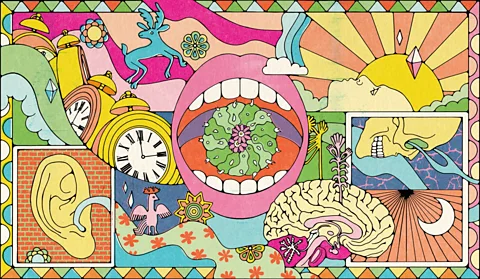 Emmanuel Lafont/BBC
Emmanuel Lafont/BBCBut ingesting substances is not the only pathway to experiencing hallucinations. Visual auras are a form of visual hallucination that typically accompany migraines. Fevers can also trigger hallucinations – they are a commonly reported symptom in malaria, for example, and were also reported by some patients during the Covid-19 pandemic. Certain illnesses like dementia, schizophrenia and some eye diseases can also cause hallucinations – sometimes called altered visual experiences – says Prem Subramanian, a professor of ophthalmology at the University of Colorado. Musical hallucinations have also been reported in association with hearing loss in some people. Grief too has been linked with hallucinations, with people reportedly hearing and even seeing a deceased partner.
But it's also possible for people to hallucinate if exposed to certain bright or flickering lights.
Exactly why we see these illusions is something of a puzzle, but we are now starting to unravel what happens in the mind during visions by comparing drug-, stimulus- and disease-induced hallucinations.
For example, the brilliance of snow might explain why some explorers and mountaineers claim to see strange figures following them during whiteouts. Sir Ernest Shackleton mentioned the sensation in his 1919 Antarctic expedition diary, South, saying that "during that long and racking march of 36 hours over the unnamed mountains and glaciers of South Georgia, it seemed to me often that we were four, not three".
One explanation for this particular illusion could be the Ganzfeld effect. If exposed to a continuous, uniform stimulus (for example, staring at a single wavelength of light) our brains try to make sense of the signal, and add in information which isn't there – generating hallucinations. You can see some of the BBC Reel team trying out the effect for themselves.
The Dreamachine
Because light-induced illusions can be created in controlled environments, they might help researchers to discover the origin of hallucinations. The fact that flickering lights on closed eyes causes visions of colours, shapes and movement is "one of the oldest findings in neuroscience", says Anil Seth, a professor of neuroscience at the University of Sussex, and the lead scientist on the immersive art-and-science project Dreamachine.
Created as a tool to capture the diversity of the public's inner minds by using strobing lights to induce hallucinations, the Dreamachine has been touring the UK during 2022. It is based on a little-known invention from 1959 by the same name. With the promise of being able to experience psychedelic hallucinations without drugs, I ventured in.
The machine itself is a two-storey high, blue, octagonal box. About 20 participants are led through a curtain and into a circular central room. Around the edge of the room are curved seats that recline back so that the participants can stare upwards towards the ceiling. In the centre of the ceiling is a flat, white disc that gives off a gentle glow, around which there is a ring of large lights – the kind you might see in a theatre.
I lie back in the seat. The experience begins with some slow electronic music coming from the speakers behind me. The lights fade up and I'm surprised by just how bright they are. I'm squeezing my eyes shut but it's still a little bit unpleasant. Through my eyelids, the bright white light looks pinky orange. Then the lights start to strobe.
The pinky orange alternates with flashes of blue, which is the result of "bleaching desensitisation". If you've ever accidentally looked at a bright light for too long and noticed smudgy blotches in your vision for a period afterwards it's the same effect. The light receptors in your retina are over stimulated and take a short while to recover.
In the Dreamachine, the orange and blue colours start to overlap, and after a few minutes I notice that I'm seeing stripes and criss-cross patterns. These kinds of effects, caused by strobe lighting, are called flicker phosphenes, and are visually similar to the simple hallucinations that drugs can induce. These simple geometric patterns probably originate in the primary visual cortex.
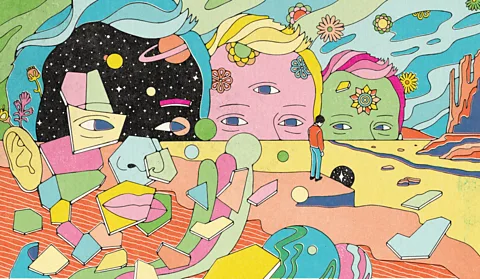 Emmanuel Lafont/BBC
Emmanuel Lafont/BBCSeth says that the frequency of the strobing determines the strength of the hallucination by syncing with the frequency of brainwaves in this region of the brain. "The most effective frequencies of the strobe lights are at around 10-15 Hz. [This] frequency range is similar to the alpha rhythm in the brain, which is very prominent over the visual cortex," he says. Other research suggests that the frequency might also determine the shapes seen. At 20–30 Hz, some people report spirals, waves, concentric circles, and lines, while at 10 Hz, zigzags, honeycombs, and rectangles.
"There's a lot of disagreement about what the alpha rhythm does," adds Seth. "It becomes more prominent when you close your eyes and when you're relaxed. Some [neuroscientists] say it's just an idling state of the brain when it's doing nothing. Others argue that it's very deeply involved in how we perceive the world – that each cycle of an alpha rhythm, each 100-millisecond period, is a frame of visual perception."
As the music changes, the stripes I can see become waves. I start to see little white spots, like a universe of stars, swirling behind the coloured waves. Then the music changes and the colours follow. The scene now looks like a desert landscape – beiges and browns stretching off into the distance – except with dark tower blocks on the horizon which I am flying towards. I have no idea if the frequency of the strobing has changed, but the shapes I can see are continually in flux.
"Nobody exactly knows quite how the Dreamachine works, we just know that it does," says Seth. He speculates that it might be because the brain is not expecting any visual input – the eyes are closed – yet is getting some information because the light is so bright. "It's trying to make sense of that visual input, but it can't make much sense of it."
"One of the most interesting focus groups was with visually impaired people – not totally retinally blind but people with severe visual issues – it was a really, profoundly moving experience," he says. "They seem to report similar things to what we're seeing in the general public. And that, for me, is pretty fascinating."
Like in a dream, I have a sense that time is moving forwards, but I have no idea how long the machine has been running or how long is left. At one point I notice that I'm barely paying attention to what I'm seeing anymore and I wonder if I had briefly fallen asleep. But I snap back into the moment.
The desert has now been replaced by multicoloured geometric shapes, like a simple kaleidoscope or an abstract, tessellated stained glass window. There are bright lime greens, yellows, blues and reds. The shapes move towards me, as though the window is breaking apart. I am reminded of the guide at the start who explained that all the colours I can see are generated by my brain. It's the most compelling part of the experience yet, and when the scene changes to something else I miss the colourfulness of the stained glass.
Why the brain creates colours, shapes and patterns in the Dreamachine is still not clear – but that is what Seth and his colleagues are trying to work out. He says that the patterns people see are very related to aspects of the wiring of the primary visual cortex. "It's almost as if the strobe light is activating these visual regions."
Colour vision is a fascinatingly subjective experience. The viral #thedress photo from 2015 that divided the internet is a case in point, says Seth. So, the age-old question of whether you and I see the same colours has a simple answer – we don't. In fact, our own perception of colours continually changes.
In summer, the colour yellow shifts slightly towards green, and in winter it shifts towards red, for example. This might be because during the summer we see more green light reflected from vegetation. We compensate for the extra green we are seeing, which means that a greenish yellow looks more like pure yellow in the summer, explains Lauren Welbourne, a psychologist at the University of York in the UK.
"This idea of having different experiences of the shared environment isn't just confined to the Dreamachine, it's happening everywhere and all the time," says Seth, who is also the author of Being You: A New Science of Consciousness. "We all have a unique perceptual experience, a unique inner universe. Very little is known about this kind of inner diversity."
Exploring that inner diversity is part of Seth's next project. He and a team of scientists and philosophers are collecting a snapshot of the public's uniqueness in a perception census, designed to bring out the variety of the public's subjective experiences with a few simple questions.
Back in the Dreamachine, the music and lights fade away, and the guides tell us the experience is over. I compared my experiences with another participant, and while there were similarities – a sense of 3D space, swirling stars and galaxies, and geometric shapes – it's also clear that our journeys through our minds were quite different. It’s this inner uniqueness that Seth and his colleagues hope to capture in their census.
A complex picture
While the simple colours and patterns I saw were interesting, they pale in comparison to the vivid testimonies of people who have drug-induced or medical hallucinations. Why might those visions be so much more complex?
Ayahuasca and cane toad toxin contain the neurotransmitter DMT, which is closely related to serotonin, melatonin, and psilocybin – the latter of which is the chemical that gives magic mushrooms their hallucinogenic properties. Serotonin and melanin have a role in controlling sleep, while serotonin is also responsible for feelings of hunger, our mood and for feeling rewarded.
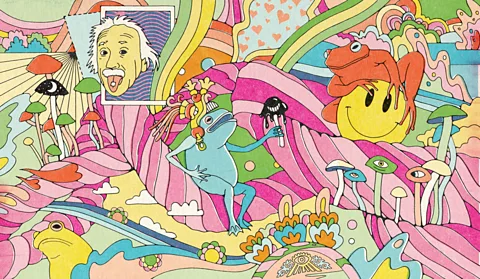 Emmanuel Lafont/BBC
Emmanuel Lafont/BBCThe links between serotonin and substances like DMT and psilocybin might go some way to explain how these psychedelics work. DMT, psilocybin and the lab-made hallucinogen LSD all activate serotonin receptors in our brains. Activation of these serotonin receptors by hallucinogenic drugs appears to be one cause of complex visual hallucinations, and some of the trippier effects of psychedelics.
In one study, participants were given controlled doses of LSD and another chemical called ketanserin, which blocks serotonin receptors, to see what role these receptors have in psychedelic trips. With the receptor unblocked, participants found that previously meaningless music became meaningful and profound after taking LSD. Blocking the receptor with ketanserin prevented these meaningful feelings.
It might explain why psychedelic trips are often accompanied by profound feelings, suggests Katrin Preller, assistant professor at the University of Zurich, who is the lead author of the paper. In a later study, Preller found that LSD leads to an increase in the connectivity of the brain networks associated with our senses, which could explain why our senses become heightened.
Drug-induced hallucinations tend to range from brightly colored geometric shapes like lattices, cobwebs, tunnels, and spirals to scenes or landscapes which can contain people, animals, spirits, aliens and monsters. There are similarities between the former types of hallucinations and the aura that migraine sufferers will be familiar with.
"Hallucinations that come from the primary visual cortex are more unformed," says Subramanian. "They are going to be sparkles, lights and shapes." Migraine auras are a common medical example of this, he adds, and much less frequently he sees brain tumour patients with similar symptoms.
But complex hallucinations can be bizarre and frightening, containing scary images of faces, people or objects. While sometimes drug-induced, these hallucinations can also be a symptom of several diseases, from schizophrenia to dementia.
One of the more curious examples of disease-related hallucinations is Charles Bonnet syndrome, which is the result of eyesight loss. Damage to the retina, or anything that can reduce light passing through the eye, like a cataract, can cause patients to see hallucinations, which can range from geometrical patterns to disembodied faces and costumed figures. It is not known how vision loss causes these hallucinations, but it is thought that as the eyesight deteriorates the brain starts to compensate for the missing information and spontaneously creates made up images.
Charles Bonnet syndrome is sometimes called "phantom vision" and has been compared to phantom limb syndrome, where amputees believe they still have their missing limb.
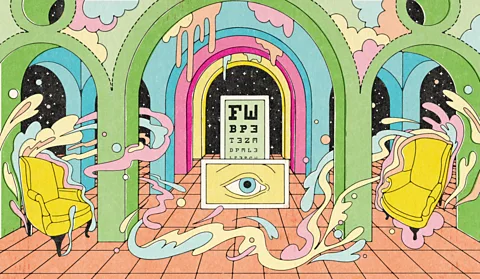 Emmanuel Lafont/BBC
Emmanuel Lafont/BBCAnother visual oddity is palinopsia, where people see the same image frozen for a brief period of time. For example, if you stare at a chair on one side of the room, and then looked over to the other side, it might appear that the chair has teleported across the floor. This is caused by delays in the retina refresh rate. The photopigments in our retinas take a fraction of a second to refresh after being stimulated. Usually this happens very quickly – it's why movies shot at 30 frames per second look like seamless movement. But in palinopsia patients, the refresh rate slows significantly, meaning images can get stuck in the vision.
Unlike induced hallucinations – which require an external stimulus like a drug or light – Charles Bonnet syndrome and palinopsia are examples of released hallucinations that happen spontaneously. Subramanian says that errors in the normal process by which vision is regulated can create visions.
"Even patients with what we might think of as mild to moderate visual impairment can have these release hallucinations," he says. "There are a good number of patients who have glaucoma or macular degeneration, who experienced visual hallucinations, but they don't want to tell anyone about it, because then they think they're crazy. And so it's very important that doctors who take care of those patients be alert to the fact that it's relatively common for them to experience these hallucinations."
Subramanian urges anyone experiencing hallucinations that are outside of the ordinary not to ignore them and to seek medical advice to make sure there's nothing abnormal.
There were no lasting effects of my time in the Dreamachine. Unless there is a reason why flashing lights might cause you problems, light-induced hallucinations can be a revealing and interesting experience.
Understanding why each of our experiences in the Dreamachine will be slightly different might remain out of reach for now, but perhaps Seth and his colleagues will get us a little closer to knowing the full range of our inner experiences.
* William Park is a senior journalist for BBC Future and tweets at @williamhpark
--
